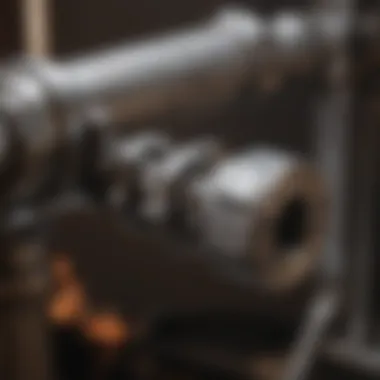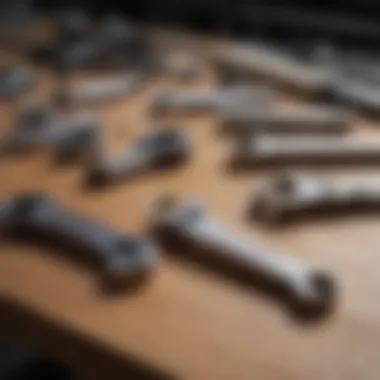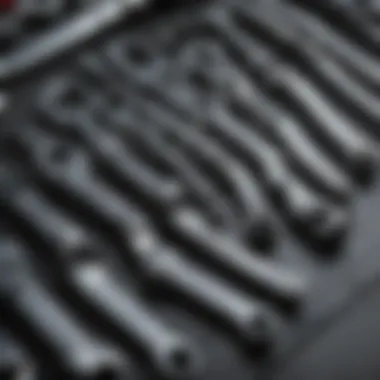Exploring the Best Flare Nut Wrenches: A Comprehensive Guide


Intro
Flare nut wrenches are an essential tool not only for mechanics but also for homeowners managing their plumbing systems. Understanding this specific tool is crucial for successful repairs and installations, mainly because of its unique design tailored to grip and turn the hexagonal nuts found on brake lines and fuel lines. When worries about water leaks arise, the right flare nut wrench can make the difference between a speculative solution and a confirmed resolution.
In the home improvement industry, strong and durable tools are crucial. A flare nut wrench stands out due to its effectiveness in accessing tighter spaces and its versatility across different applications. Comprehending flare nut wrenches encompasses knowledge about their functionalities, suitable materials, and various usage contexts - from plumbing tasks to automotive repairs.
Importance of the Topic
Flare nut wrenches help homeowners maintain systems that rely on threaded tubing. These tools not only simplify securing fittings; they also ensure the integrity than can influence the overall functioning of household systems – like water delivery, gas flow, and heating systems. For enthusiasts of DIY improvements, this tool becomes a significant ally, facilitating effective solution resolutions without the need to consult a professional for every minor job. Achieving essential repairs swiftly enriches home maintenance into a fulfilling venture.
Common Challenges and Solutions
One common challenge that homeowners face with flare nuts is rounded-off or corroded fittings, which can render standard wrenches ineffective.
Solutions and Tips
- Ensure that you select a wrench designed for the specific size of flare nuts which can help prevent such challenges.
- Employ a penetrating oil, like WD-40, on stubborn nuts before attempting to remove them to ease the process.
Some homeowners also struggle with poor grip on flare nut nuts, especially when it's difficult to reach critical areas. In these cases, a specially designed flare nut wrench is much better than broader tools. Selecting the right tool for each project ensures not only comfort but also satisfaction in achieving desired outcomes.
Product Recommendations
When determining the right product, quality and reliability stand out among the selection process of various flare nut wrenches. Consider the tools from reputable brands like:
- GearWrench - Known for offering both comfort and functionality, these wrenches provide an excellent grip and leverage.
- CR-MO Pro - Their flare nut wrenches feature anti-slip designs and are known for being user-friendly and durable in demanding tasks.
Through diligent research and careful selection of reputable tools, house owners can enhance their capability to solve issues, prevent leaks, and affect broad repairs across the competence range required in everyday maintenance tasks.
Step-by-Step Guides
Implementing the right flare nut wrench properly allows for concurrent and efficient handling of home concerns. Here’s a step-by-step process using a flare nut wrench effectively:
- Identify the right wrench size - Confirm the size of the nut to ensure your wrench will fit securely.
- Prepare the surroundings - Clear unobstructed access to where you plan to work.
- Apply penetrating oil - Use it if the nut is corroded or difficult to turn.
- Place the wrench - Position the wrench snug onto the nut, ensuring a tight grip.
- Turn the wrench gently - Gradually applying force prevents damage to the fixture, ensuring safety.
- Carefully remove the nut - Once it is loosened, disconnect it entirely.
By following these steps, you significantly reduce the chance of damaging the surrounding area and securing desirable outcomes on your repair task. It may be handy for hose-whist needing flexibility and breadth to successfully navigate the subject matter associated with flare nut wrenches.
Understanding Flare Nut Wrenches
Flare nut wrenches occupy a critical niche in the world of hand tools. These specialized tools are designed primarily for use in both automotive and plumbing applications. By understanding what flare nut wrenches are and their unique design motivations, users can appreciate why they are essential for specific tasks. Knowing the model that suits one's needs could greatly simplify various processes, from working on vehicle brake lines to loosening fittings in pipework.
Definition and Purpose
A flare nut wrench, also known as a line wrench, is a specific type of wrench that has a rounded opening, allowing it to grip the hexagonal or rounded edges of fluid fittings. This enables the wielder to apply force without damaging structures such as hoses or pipes. The purpose is clear: these wrenches are built to handle the unique demands of fittings that require a firm yet delicate touch.
In practical use, the flare nut wrench ensures the user can exert maximal torque without rounding off the fitting edges. The tool's design allows users to access fasteners that ordinary wrenches can't reach, proving particularly useful in confined spaces where precision work is necessary. By using a flare nut wrench, both functionality and protection come together in a useful synergy.
How They Differ from Standard Wrenches


Flare nut wrenches differ markedly from standard open or closed-end wrenches. Most significant is their design; where standard wrenches typically have straight openings, flare nut wrenches feature a slot that contours more to the fitting shape. This makes them better suited for various tasks, particularly those that involve cap nuts or fittings that traditionally are difficult to extract.
Moreover, the contact that a flare nut wrench has with a fitting is broader and carries less risk of slipping, which means it lends itself to safe application under high torque situations. This contrasts sharply with standard wrenches that can frequently create damage in such circumstances due to their slipping motion. Understanding these differences not only aids in tool selection but also ensures time and resources are optimized during standard home maintenance tasks, repairs, or auto work.
This specialization significantly adds to both reliability and precision in places of application, proving indispensable for tasks often confronted by both seasoned mechanics and novices alike.
Key Features of Quality Flare Nut Wrenches
Understanding the key features of quality flare nut wrenches is crucial for users. These basic aspects determine their efficiency, usability, and longevity. Quality wrenches not only perform better, but they also provide a better user experience. Factors such as material composition and design characteristics significantly influence their performance and reliability in various applications.
Material Composition
Materials play a vital role in the overall quality and durability of flare nut wrenches. Most commonly made from steel or stainless steel, users often face a decision in selecting the appropriate type based on their needs.
Steel vs.
Stainless Steel
Steel is a strong and sturdy option, often preferred for its affordability and accessibility. Its sheer strength makes it effective for heavier mechanical tasks. Stainless steel, on the other hand, offers superior corrosion resistance. This is particularly important for those who frequently encounter moisture or corrosive substances.
One unique feature of stainless steel is its ability to maintain functionality over prolonged exposure to harsh conditions. In contrast, while regular steel may require additional protective coatings, the long-term lifespan of stainless steel tends to be a significant advantage. However, stainless steel is generally heavier and may be pricier, making it essential for users to balance cost, weight, and durability before making a choice.
Impact of Material on Durability
The impact of material on durability greatly influences how a flare nut wrench performs in different environments. Steel wrenches can be very durable provided they are made from high-quality alloy steel. Such materials help withstand formidable forces during application. Conversely, stainless steel's resistance to rust and wear ensures that it tends to last longer in environments with high exposure to moisture and chemicals.
Durability is not just about resistance to wear and tear. It also includes how tools handle extreme temperatures and mechanical strain. In this regard, many users find stainless steel as worth the investment due to its long-lasting nature, despite the initial higher cost. Understanding the implications of these material properties allows users to select wrenches tailored to their specific tasks.
Design Characteristics
Design plays an equally significant role in determining a flare nut wrench’s performance and efficiency. Users must be familiar with different design aspects such as open-ended versus closed options, in addition to considerations related to handle grip and ergonomics.
Open-Ended vs.
Closed Design
The choice between open-ended and closed designs typically depends on the specific tasks at hand. Open-ended wrenches are beneficial since they allow users to work on fasteners located in tight areas. This flexibility is criitcial for removing or adjusting parts that are close to other components.
In contrast, closed design models provide additional grip around the nut or bolt, thereby reducing the chances of slipping during application. This gripping capacity can enhance safety, especially in high-tension scenarios. Both designs have their merits, making it important to understand your specific needs and constraints before making a decision on which design suits best.
Handle Grip and Ergonomics
The handle grip and ergonomics of a flare nut wrench significantly contribute to comfort during prolonged use. Wrenches with padded grips or those designed to fit the natural curve of the user's hand are essential for preventing muscular strain or fatigue.
Ergonomic designs improve handling, which can also lead to increased accuracy during tasks. Having a good grip promotes better control, thus ensuring that the wrench does not slip during use. Investing in ergonomically designed wrenches is a worthwhile consideration for users planning projects that involve repetitive motions or extended periods of utilization.
Understanding materials and ergonomic designs can greatly influence the effectiveness of flare nut wrenches. By considering these fundamental elements, users can better select tools that will perform well in various contexts, enhancing both the efficacy and enjoyment of related tasks.
Applications of Flare Nut Wrenches


Flare nut wrenches serve a crucial role in various cspe sections, notably in automotive and plumbing fields. Understanding their applications can significantly influence tool selection and effectiveness. The choice of the right wrench affects task efficiency and the quality of work performed. Proper handling ensures safe and reliable operations, minimizing the risk of tool failure.
Common Uses in Automotive Work
In automotive work, flare nut wrenches are essential for tasks requiring the application of torque to flare fittings commonly found in brake lines and fuel systems. Their design enables a secure grip around nut surfaces without the risk of slipping or rounding off. This characteristic is vital because many automotive connections depend on precision and reliability.
Some common automotive applications include:
- Brake Line Repair: Regular service of brake systems involves the removal and installation of flare fittings.
- Fuel System Maintenance: Wrenches help in situations where fuel lines need to be disconnected or reconnected securely.
- Hydraulic Line Installations: These wrenches support the assembly and disassembly of hydraulic brake systems.
A skilled mechanic will affirm that efficiency and safety largely depend on proper wrench use. Consistent valve handling reduces work risk on critical car systems.
Importance in Plumbing Projects
In plumbing, flare nut wrenches prove equally significant. Plumbers commonly employ these tools for fixture installations, maintenance, and repairs. As gas and water lines often use flare fittings, a claim by repairs or installations without the right tool can lead to leaks or mishaps.
Key plumbing applications consist of:
- Water Supply Lines: Connecting copper tubing to fixtures or valves requires a proper fit.
- Gas Line Installations: These connections benefit from accurate tightening mechanisms to avoid leaks.
- Pipe Remodeling: When changing under-sink assorted connections, proper tool size is essential for efficient operation.
Plumbers appreciate the unique design aspect of flare nut wrenches, allowing clearance and support where standard tools fall short. Their specialized function ensures a reliable, protected connection across services.
Utilizing a flare nut wrench avoids common missteps in automotive and plumbing anyting and optimizes functional safety.
Selecting the Best Flare Nut Wrench
When it comes to choosing a flare nut wrench, selecting the right one is crucial for accomplishing your specific tasks effectively. Flare nut wrenches come in various designs and sizes. Understanding these details can enhance efficiency. Users need to know their requirements and how the selection plays a part.
Factors to Consider
Size Range and Compatibility
The size range of flare nut wrenches significantly influences their usability. Compatibility determines whether the wrench can fit various sizes of fittings. A product that offers a broader size range allows for versatility. Particularly, some projects require more than one size for effective results. Choosing a wrench that fits a wide variety of tasks ensures you won't encounter difficulties.
A key aspect of size consideration is the variety of nut sizes on vehicles or plumbing systems. Many Quick connectors, used in plumbing and automotive jobs, have specific sizes. Using a wrench that fits properly prevents damage to both the nut and the tool. With sizes like 7/16
Care and Maintenance of Flare Nut Wrenches
Proper care and maintenance of flare nut wrenches is crucial for ensuring their longevity and efficient performance. Regular maintenance not only extends the life of the wrenches but also enhances their effectiveness in various applications, whether in plumbing or automotive tasks. Understanding how to treat these tools correctly allows users to avoid potential damage and costly replacements. Engaging with proper maintenance practices is a smart investment for both professionals and DIY enthusiasts.
Best Practices for Longevity
To maximize the lifespan of flare nut wrenches, consider the following practices:
- Cleaning After Use: Regularly wash the tools with soap and water. Avoid abrasive cleaners which could scratch or corrode the surface. Ensure they are completely dry to prevent rusting.
- Lubrication: Apply a light coat of oil every few uses to protect moving parts and maintain ease of operation. Oil reduces friction, preventing wear during use.
- Storage Conditions: Store your wrenches in a dry location. A toolbox or a designated compartment in a drawer works well. Using a protective case can guard against physical damage and environmental factors.
- Avoid Over-Tightening: When using these tools, do not apply excessive force. Doing so can distort the tool, making it less effective for future tasks. Be mindful of the torque specifications of the nuts or fittings being worked on.
Set these practices into routine, and your wrenches will serve well for years.
Common Issues and Solutions


Despite proper use and maintenance, flare nut wrenches can encounter issues. Here are typical concerns and how to address them:
- Rust Formation: If neglected, rust may develop over time, especially in high-humidity environments. Solution: Clean the wrench and apply a rust inhibitor oil to prevent further corrosion.
- Loss of Grip or Slippage: Over time, the gripping surfaces may wear out, leading to reduced functionality. Solution: Inspect for wear. Consider replacing the wrench if damage is extensive to ensure safe usage.
- Misalignment: Continuous use on different fittings may lead some wrenches to become misaligned. Avoid forcing a wrench onto a nut that doesn’t fit properly. The result may be damage to both the wrench and the nut.
By addressing these common issues proactively, users can maintain their flare nut wrenches effectively, maintaining functionality and safety.
Effective care of your flare nut wrenches saves time and money, enhancing usability every time they are reached for.
User Testimonials and Feedback
User testimonials and feedback are vital elements in any guide regarding tools, including flare nut wrenches. Real-world experiences shared by users create practical and relatable insights beyond mere specifications and features of a tool. These testimonials can help potential buyers make informed decisions tailored to their needs. Insights from those who use flare nut wrenches routinely in the field allow other users to see not only the strengths of various models but also the drawbacks.
Understanding how different professionals apply these tools solidifies the guide's value. User feedback often highlights unanticipated situations where a tool shines or discloses weaknesses that standard reviews might ignore. Additionally, the shared narratives might address essential questions regarding comfort, usability, and effectiveness.
By anchoring user experiences into the narrative, the article becomes a resource rich in practicality. Here it extends beyond a mere technical overview to uncover how specific models impact the working environment, productivity, and overall satisfaction.
Insights from Automotive Professionals
Automotive professionals offer a wealth of knowledge through their daily interaction with various tools, including flare nut wrenches. During interviews and discussions with mechanics and auto technitians, certain themes frequently arise. Many state that a well-designed flare nut wrench significantly eases tasks involving hydraulic lines and fuel systems.
Several users shared experiences where the ideal wrench allowed for precision connection, minimizing the chance of leaks. Flexibility in reach and angles is often echoed—they appreciate wrenches that excel in axial spaces. One mechanic commented, "A good flare nut wrench hasn't let me down in tight spots. It provides the grip needed to avoid stripping nuts."
While weight and ergonomics come up often, users express satisfaction with lighter wrenches made from durable material. This does not only reduce hand fatigue but also improves overall efficiency due to less exertion during prolonged tasks.
It's clear from automotive feedback that tools such as Ingersoll Rand offer tools that often join the ranks of some oft- recommended flare nut wrenches.
Plumbing Experts' Experiences
In plumbing, the requirements for flare nut wrenches are different but equally important. Industry experts emphasize the necessity for a strong and compact design that permits tight handling. Many plumbers express appreciation for the versatility of a quality flare nut wrench, allowing a smooth job whether dealing with gas or water lines.
"Using the right flare nut wrench can make or break a plumbing operation," said one plumbing contractor. Reliability is the key. Tests made by experts lead them toward brands like Milwaukee as favorites, especially due to their solid construction. Guaranteed performance under high-pressure situations stands crucial in plumbing work, prompting professionals to share recommendations based on try-and-tested functionality.
Furthermore, testimonials highlight issues related to slipping and misfit. In a category where precision is required for safety, a wrench’s design becoming unable to grip precisely matches plumbing expectations forms a critical conversation space. Experts advise ensuring the selected wrench truly fits the respective fittings for optimal safety and performance.
Epilogue: Making an Informed Choice
Choosing the right flare nut wrench is not merely about having an additional tool in your toolbox. It's about making an informed decision that can affect the quality of your work. This section wraps up by emphasizing important aspects of utilizing the knowledge acquired throughout this article. Understanding the key features, materials, and applications discussed earlier can significantly enhance your overall tool selection process.
By considering the performance and reputation of different brands and models, you equip yourself with the ability to confidently navigate your purchasing options. The ideal flare nut wrench should not only meet your immediate needs but also stand the test of time. Investing wisely can save you not just money but also time and effort in the long run.
Summary of Key Points
Here, we briefly summarize the essential findings from this guide.
- Material is essential: Different materials, particularly steel and stainless steel, impact the durability and responsiveness of a flare nut wrench.
- Design matters: The design, whether open-ended or closed, will influence the ease of use depending on where and how you are working.
- Application insights: Flare nut wrenches serve specific purposes, mainly in automotive work and plumbing projects, which should guide your selection.
- Brand selection: The big names in the market, like Craftsman or GearWrench, provide proven reliability, but newer brands might offer innovative features worth exploring.
The thoughtful consideration of these points is crucial for informed decision-making.
Final Recommendations
Here are some actionable recommendations based on the cumulative insights shared throughout this article.
- Assess your specific needs: Determine what applications you will be using the flare nut wrench for. This dictates size, design, and material requirements.
- Choose reputable brands: Stick to brands like Klein Tools or Tekton for better customer service and warranties.
- Don’t overlook ergonomics: Prioritize wrenches with comfortable grips, as they will enhance the usability during extended work periods.
- Read reviews and user experiences: Testimonials from web resources can provide valuable insights into real-world performance.
In the end, combining thorough knowledge with practical choices will lead to a satisfying and effective purchasing decision, ensuring that your flare nut wrench works efficiently for your automotive and plumbing tasks.







